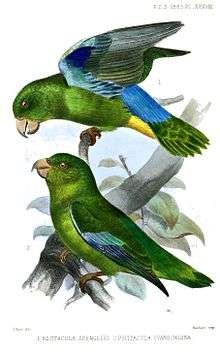Turquoise-winged parrotlet
The turquoise-winged parrotlet (Forpus spengeli) is a species of parrot in the family Pscittacidae.
| Turquoise-winged parrotlet | |
|---|---|
 | |
| Illustration of a turquoise-winged parrotlet (Forpus spengeli) (top) and green-rumped parrotlet (Forpus passerinus) (bottom) | |
| Scientific classification | |
| Kingdom: | Animalia |
| Phylum: | Chordata |
| Class: | Aves |
| Order: | Psittaciformes |
| Family: | Psittacidae |
| Genus: | Forpus |
| Species: | F. spengeli |
| Binomial name | |
| Forpus spengeli (Hartlaub, 1885) | |
| Synonyms | |
| |
Description
Turquoise-winged parrotlets are typically 12 centimetres (4.7 in) long and weigh about 28 grams (0.99 oz). Their bodies are mostly yellow-green; eyes are dark brown and legs and beak are light peach. Turquoise-winged parrotlets are sexually dimorphic: males have bright turquoise feathers on their lower backs and rumps, and have purple-blue underwing coverts and axillaries. Females have no blue markings, but their foreheads and faces are brighter yellow-green than males'.[2] Like all parrots, turquoise-winged parrotlets exhibit zygodactyly: two toes face forward and two toes face backward.
Distribution and Habitat
Turquoise-winged parrotlets are found in northern Colombia from the Caribbean coastal region southwest of the Santa Marta Mountains, Atlantico, and south along the Rio Magdalena in Bolívar and Cesar.[2]
Turquoise-winged parrotlets are most often found in drier, open or riparian woodlands, cerrado, caatinga, savanna, palm groves, semi-arid scrubland, and pastures.[2]
Conservation
There is not an estimate for the number of turquoise-winged parrotlets, but it is believed that their population is decreasing because of increased human interference and habitat destruction.[2] Turquoise-winged parrotlets are listed as Least Concern by the IUCN Red List.[1]
Behavior and Ecology
Social
Turquoise-winged parrotlets are highly gregarious and are often found in flocks of up to 50 birds.
Reproduction
The turquoise-winged parrotlet's breeding season is May to August. Females lay 3-7 small white eggs.[2]
Diet
Turquoise-winged parrotlets mostly feed on Cecropia sp. fruits,[3] Mikania sp. and Trema micrantha seeds, and Ambrosia sp. and Marcgravia sp. flowers. They are also known to occasionally feed on other plants such as grass.
Taxonomy
Until recently, the turquoise-winged parrotlet was considered a subspecies of the blue-winged parrotlet as Forpus xanthopterygius spengeli. However, in 2015 Bocalini and Silveira studied morphological differences between subspecies of blue-winged parrotlets and determined that the turquoise-winged parrotlet was its own species, F. spengeli.[4] This split was supported by Donegan et. al. in 2016.[5] There is continuing debate over the validity of this change. Some taxonomic authorities (including the American Ornithological Society) do not recognize this change in classification.[6]
References
- BirdLife International (2016). "Forpus spengeli". IUCN Red List of Threatened Species. 2016: e.T45428679A95153318. doi:10.2305/IUCN.UK.2016-3.RLTS.T45428679A95153318.en.
- "Turquoise-winged Parrotlet (Forpus spengeli) | Parrot Encyclopedia". www.parrots.org. Retrieved 2019-03-17.
- Wheeler, W.M.; Darlington, Jr., P.J. (June 1930). "Ant-Tree Notes from Rio Frio, Colombia" (PDF). Psyche. 37 (2): 116 – via Antwiki.
- Bocalini, F.; Silveira, L.F. (May 2015). "Morphological variability and taxonomy of the Bluewinged Parrotlet Forpus xanthopterygius (Psittacidae)". Revista Brasileira de Ornitologia. 23: 64–75 – via ResearchGate.
- Donegan, T.; Verhelst, J.C.; Ellery, T.; Cortés-Herrera, O.; Salaman, P. (October 2016). "Revision of the status of bird species occurring or reported in Colombia 2016 and assessment of BirdLife International's new parrot taxonomy" (PDF). Conservación Colombiana. 24: 17–21.
- "A classification of the bird species of South America". www.museum.lsu.edu. Retrieved 2019-03-17.
